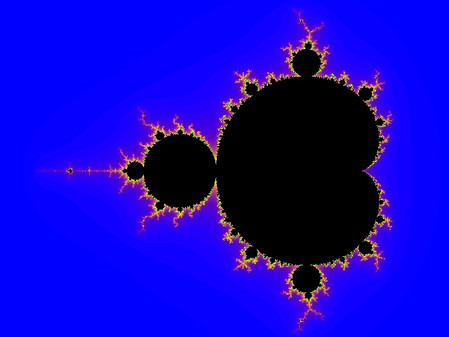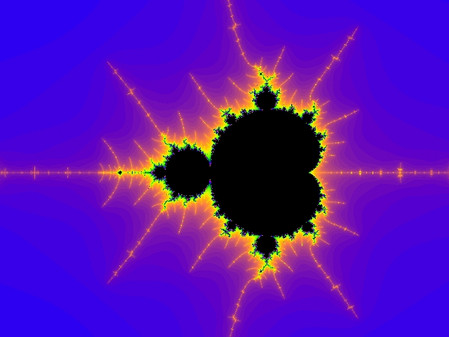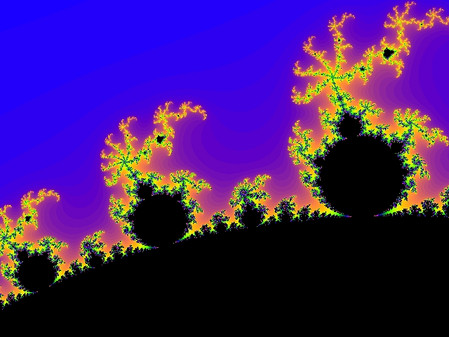About Fractals
(Every information on this page accords to my understanding of the matter. Errors are possible.)
In the following text I want to give a short description of what fractals, as shown in the galleries, actually are.
Basically, fractals are mathematical structures created by formulas. But don't be scared by this. I will try to explain the basics in a simple way.
(The footnotes aim at the mathematically interested.)
I want to give the explanations using the Mandelbrot set as an example, since this fractal started the whole development, and it is also a very simple example (see picture 1).

|
|
picture 1: the classic Mandelbrot set
|
Jumping on a Plane
The geometrical basis of the Mandelbrot set is the two-dimensional plane [1]. One can define a specific sequence of points of this plane by choosing both a starting point and a rule of computation, which, given a point, calculates another point [2]. With this rule of computation one can, given the chosen starting point, calculate the second point of the sequence. With this second point, one can calculate the third, the fourth etc. point, and so get the whole sequence.
The important quality of such a sequence is whether it is "bounded". "Bounded" here means that all points of the sequence are within a bounded area (such as a circle with a specific radius) [3].
Now, the Mandelbrot set is determined by taking a specific rule of computation [4], taking one point of the plane (or rather, pixel) after another as a starting point, and then calculating whether the resulting sequences are bounded. If one sequence is, the corresponding point is colored black. If not, the point gets a color depending on how "fast" the sequence moves away (the wider the "jumps", the faster). The colors can be chosen freely; this freedom of choice is also important for the arrangement of a picture.
These calculations are so extensive that they can only be done by a computer. So, a fractal picture has, in a way, three different authors: mathematics (Nature?), the computer and the human being who arranges. (The Mandelbrot set itself was, by the way, discovered by accident while working with a computer.)
The fractals shown in the galleries are basically calculated in the same way as the Mandelbrot set, but with considerably more difficult rules of computation [5]
It is remarkable that such rich objects can be archived in such a, actually quite simple, way.
The next topic deals with the most outstanding quality of fractals, self-similarity.
Self-similarity
Self-similarity means that one can find similar objects at different scales within one picture [6] (see picture 2).

|
|
picture 2: part of picture 1, magnified by a factor of 32
|
This sequence of pictures illustrates the "descent" into a self-similar structure
Closely related with self-similarity is the "fissuredness" of structures like e.g. the boundary between the black and the colored area (see picture 3).

|
|
picture 3: a part of the boundary in picture 1
|
Therefore, by the way, the boundary is infinitely long.
The quality of self-similarity can also be found in the material nature in manifold forms, like e.g. rocks, plants, sand, clouds, snow flakes etc. where one cannot -at least at specific scales- tell how large a part of the structure, shown e.g. on a photography, is.
Benoit Mandelbrot even speaks of the "fractal geometry of nature".
An other widely known example is the coast of England, which is therefore often to be said to have an infinite length. But since a coast consists of a finite number of atoms, it is, being physical, only an approximation of a fractal structure in the mathematical sense.
More Information
For further information not only about fractals and philosophical questions about fractals (e.g. about platonism and mathematics), but also about physics, theoretical computer sciences, artificial intelligence etc., the book "The Emperor's new Mind" by Roger Penrose is recommended.
Concerning the Philosophy of Fractals
Why is mathematics able to depict correctly the structure of the world? Here, this is the fundamental unanswered philosophical question. Do we invent mathematics or do we discover it? [7]
Fractals, as sensually perceptible structures, make this question particularly obvious.
On this page, I intend to collect interesting texts and qoutes concerning this matter.
This I want to start with a text by Roger Penrose, taken from his mentioned book "The Emperor's new Mind" (Oxford Universtiy Press, 1989, 94-95)
Platonic reality of mathematical concepts?
How ’real’ are the objects of the mathematician's world? From one point of view it seems that there can be nothing real about them at all. Mathematical objects are just concepts; they are the mental idealizations that mathematicians make, often stimulated by the appearance and seeming order of aspects of the world about us, but mental idealizations nevertheless. Can they be other than mere arbitrary constructions of the human mind? At the same time there often does appear to be some profound reality about these mathematical concepts, going quite beyond the mental deliberations of any particular mathematician. It is as though human thought is, instead, being guided towards some eternal external truth — a truth which has a realitv of its own, and which is revealed only partially to any one of us.
The Mandelbrot set provides a striking example. Its wonderfully elaborate structure was not the invention of any one person, nor was it the design of a team of mathematicians. Benoit Mandelbrot himself, the Polish-American mathematician (and protagonist of fractal theory) who first studied the set, had no real prior conception of the fantastic elaboration inherent in it, although he knew that he was on the track of something very interesting. Indeed, when his first computer pictures began to emerge, he was under the impression that the fuzzy structures that he was seeing were the result of a computer malfunction (Mandelbrot 1986)! Only later did he become convinced that they were really there in the set itself. Moreover, the complete details of the complication of the structure of Mandelbrot's set cannot really be fully comprehended by any one of us, nor can it be fully revealed by any computer. It would seem that this structure is not just part of our minds, but it has a reality of its own. Whichever mathematician or computer buff chooses to examine the set, approximations to the same fundamental mathematical structure will be found. It makes no real difference which computer is used for performing calculations (provided that the computer is in accurate working order), apart from the fact that differences in computer speed and storage, and graphic display capabilities, may lead to differences in the amount of fine detail that will be revealed and in the speed with which that detail is produced. The computer is being used in essentially the same way that the experimental physicist uses a piece of experimental apparatus to explore the structure of the physical world. The Mandelbrot set is not an invention of the human mind: it was a discovery. Like Mount Everest, the Mandelbrot set is just there!